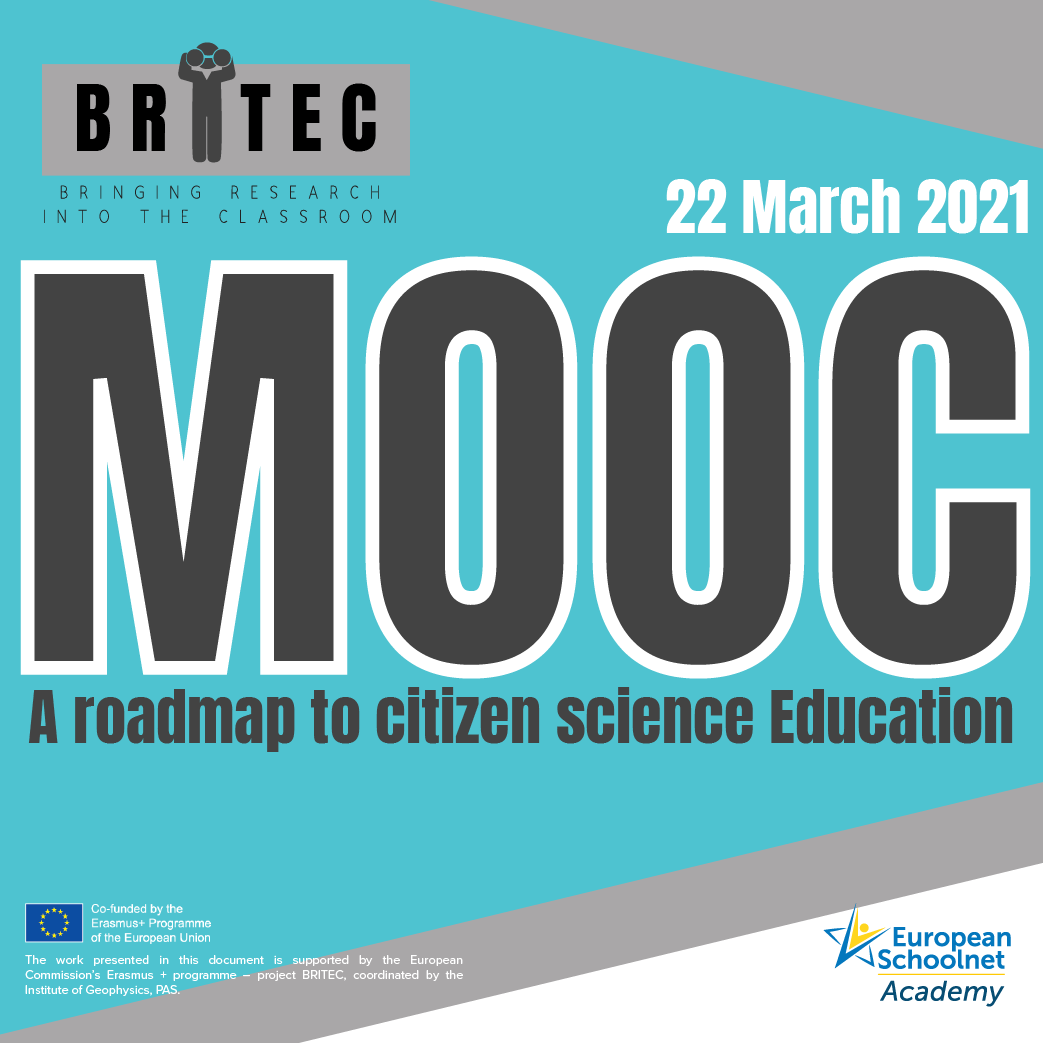Go check out our brand new videos elborated within BRITEC case studies and researchers science pills! Scientists and Teachers share their experiances from implementing pilots!
Study of meteors by using radio techniques
The science objectives are on the one hand to calculate the directional meteoroid flux in the Earth’s atmosphere, and on the other hand the determination of meteoroid trajectories.
BRAMS (Belgian RAdio Meteor Stations, http://brams.aeronomie.be) is a Belgian network using forward scatter radio techniques to detect and study meteoroids entering the Earth’s atmosphere. It consists of one beacon and 26 identical receiving stations (often hosted at and maintained by astronomy enthusiasts).
The BRAMS network generates a huge amount of data with thousands of meteor echoes detected eachday. Which such large amount of data, it is impossible to process it all ourselves.
The automatic detection of meteor echoes in the BRAMS data has proven to be a difficult problem to solve. Therefore, the BRAMS researchers, in collaboration with Zooniverse team, have launched a citizen science project called the Radio Meteor Zoo (RMZ, http://www.radiometeorzoo.eu/) in August 2016. Since the beginning of the RMZ, more than 8500 volunteers have identified thousands of meteors.
In the framework of this BRITEC project, we want to develop educational material to bring our meteor research into the classroom, and to engage people to contribute to the RMZ.
Impact of traffic noise on people: “Build your own annoyance function.
What is the state of transport-related noise pollution in Flanders ?
In this project students walk through the entire process of an environmental impact study according the DPSIR protocol (‘driving forces’, ‘pressure’, ‘state’, ‘impact’, ‘response’). They measure noise and assess how disruptive is the noise to them personally based on a standardized noise annoyance survey, document their exposure with different techniques and compare the weaknesses and strengths of the different exposure assessment techniques. In this way they get insights in the complexity of environmental impact research.
Students complete a survey, count traffic (amount of vehicles passing by at a given location during one hour), near their homes and/or at school. Noise measurements are performed at the pupils’ dwellings. Using the traffic counts & existing sound maps, combined with the surveys the students completed, they will construct a so called ‘noise annoyance function’. They then discuss the results and debate over the potential measures that can be taken to reduce noise exposure in their daily lives.
Studies of indoor comfort and climate quality in school classrooms
What can schools do today to improve comfort and indoor air quality in school classrooms?
In Europe, the building sector accounts for about 40 % of total final energy use (Economidou, 2011). It thereby represents the largest energy use sector. Our building stock thus harbours enormous potential to save energy, and reduce carbon dioxide emissions, in a cost-effective way. Also school buildings can play an important role, as today they are often not up to standards.
Clearly, there is a need to make school buildings more energy efficient. But at the same time, indoor comfort and air quality are equally important. As a matter of fact, the promise of energy use and cost reduction alone will not carry needed energy transition. There is a need for ambitious renovations that reduce energy use and at the same time improve indoor comfort and air quality. Studies show that thermal comfort and air quality significantly impact student’s ability to concentrate and perform cognitive tasks.
Based on numerous studies, there is a reason to believe that indoor comfort and air quality are often unsatisfactory. This project aims to support sensible solutions for this issue, mainly:
- to map the current conditions with regard to comfort and air quality in our schools,
- to raise awareness amongst all stakeholders,
- to reveal cost-effective straightforward measures that schools can take today,
- to aid policy makers in defining sensible comfort and air quality criteria and in putting forward sensible roadmaps to improve school building performance.
There are two sides to comfort and air quality conditions in school classrooms: the actual conditions that we can measure, and how students and teachers perceive them.
The aim of this project is to raise awareness and shed light on the underlying physical phenomena. With small experiments and some analytical work, students are given insight into their impact on air quality, as well as the impact of heating and ventilation.
It is planned to measure indoor air conditions using wireless battery-powered devices that can measure up to 10 parameters at once. These parameters include air temperature, relative humidity, VOC’s, CO2, sound, light. The wireless sensing devices send data to secure online servers by means of the mobile data network.
It is also planned to to perform short surveys, querying students and teachers about how they perceive indoor climate.
Join the BRITEC MOOC “A roadmap to citizen science Education”!
The BRITEC project, aiming at introducing research into classrooms through Citizen Science activities, has developed a unique online course focused on integrating scientific activities in STEM teaching. The BRITEC MOOC “A Roadmap to Citizen Science Education” will provide materials and stories of implementation from innovative citizen science education projects. Explore how to combine teachers’ and scientists’ forces from 22 March 2021!
Citizen Science is a relatively new way of conducting scientific research, by enlisting the support of ordinary citizens in the collection and interpretation of data. This approach is a way of engaging pupils in research practices, as well as creating a community for teachers and researchers to exchange on how to bring research into the classroom. Citizen Science Education is based on the assumption that teachers and researchers can find a common ground of discussion and develop practices that are advantageous for both the education sector and the science sector.
Therefore, this course proposes a process of collaboration between teachers and researchers. It provides insights from the perspective of researchers who have supported teachers developing STEM learning scenarios that include scientific activities based on the needs of active research projects. The main objective of this MOOC is to provide instructional design guidelines and the necessary resources so that teachers can develop a learning scenario of their own.

The MOOC will consist of four modules, each of them fostering teachers’ skills and knowledge that are necessary for the design, development and implementation of citizen science education projects. Moreover, the modules will address how to introduce research methodologies and activities in the classroom as a way to engage pupils into STEM subjects.
Register now & join us on 22 March 2021: http://bit.ly/BRITEC-MOOC
Debata oksfordzka w praktyce szkolnej
Jesteś nauczycielem przedmiotów matematyczno-przyrodniczych? Chcesz przybliżyć swoim uczniom sztukę debatowania? A może prowadzisz kółko zainteresowań, klub naukowy i poszukujesz inspiracji? Dzięki gotowym narzędziom do pracy z uczniami i naszemu wsparciu możesz zacząć wykorzystywać debatę oksfordzką w praktyce szkolnej!
Więcej na stronie projektu Odyssey:
https://odyssey.igf.edu.pl/?p=336
Zapraszamy!
Zapraszamy do Projektu EDU-ARCTIC2!

Drodzy Nauczyciele! Mamy dla Was i dla Waszych szkół kolejną projektową propozycję! Projekt EDU-ARCTIC2 oferuje ciekawe pakiety, z którymi uczniowie mogą pracować samodzielnie lub pod Waszym okiem, a także webinaria polarne i filmy 360 stopni
To od Was zależy z ilu tematów i ilu lekcji online skorzystacie.
Wystarczy szybka rejestracja:
Wyniki konkursu na najlepszy monitoring fotograficzny
Jest nam niezwykle miło ogłosić, że konkurs na najlepszy monitoring fotograficzny podczas realizacji projektu: „Obserwacja zmian sezonowych roślinności nadbrzeżnej i warunków mikroklimatycznych rzeki” wygrała Szkoła Podstawowa w Warszawicach, która skrupulatnie prowadziła foto monitoring roślinności w Kanle Warszawickim.

Wyróżnione zostały również następujące szkoły:
– Zespół Szkół Ekonomiczno – Usługowych im. Fryderyka Chopina w Żychlinie – foto monitoring rzek: Powa i Warta na odcinku Sługocinek.
– Szkoła Podstawowa im. Jana Bosko w Celinach – foto monitoring rzeki Dłubnia.
Zdjęcia z najlepszego foto monitoringu zostaną zaprezentowane podczas 6-stego Europejskiego Kongresu IAHR w Warszawie w lutym 2021 roku.

Zwycięskiej szkole i wyróżnionym – serdecznie gratulujemy!
Analysis of students’ dietary habits
The project consists of data collection of students’ dietary habits. The data collection is being realized with the use of a dedicated app and smart phones. Students collect and analyze their dietary habits and that of their class/peers in order to support the research around indicators linked with childhood obesity; a soaring issue in Greece and globally. Students are introduced in Big Data techniques and analysis. Students collaborate with experts in the field (doctors, researchers in healthy nutrition, researchers in Big Data) and get a full insight in the specific research area.
The project aims to gather information on how healthy the behaviors and living environments of students are . With the collected information by many students we will try to detect which aspects of behavior and living environment are important to target in public health policies, so that healthy behavior can be encouraged, rather than discouraged, by the students’ living environment. The students that participate in the project (age 9 – 18) become citizen scientists by collecting data regarding their behavior and living environment with a smartphone application. Students answer questions, take pictures of food advertisements they encounter, and of the food they consume. This only take a few minutes per day.
The purpose of the study is to evaluate a series of real-life students’ dietary habits and physical activity. The data collected remain anonymous. Consent forms are signed by their legal guardians. Students who return signed consent forms and agree to participate receive registration tokens and instructions for downloading the mobile app. Students who do not agree to participate in the data collection, are only involved in the data analysis phase.
“Urban Climate and Human Bioclimatic” methodology
The combined effects of rapid urbanization, global warming, and Urban Heat Islands (UHIs; i.e., higher temperatures observed in cities compared to those of the rural surroundings) make the urban residents more vulnerable to the adverse health impacts arising from extreme heat conditions.
The aim of the present project is to increase students’ knowledge and awareness concerning the impacts of urban climate on humans. The students will learn about urban climate characteristics, UHIs and urban-scale climate change, and how these factors affect the human body. They will become “young scientists” examining the local climate in their school neighborhood in terms of meteorological and thermal comfort conditions.
(a) Climate change: Introduction to the new terminology (“climate crisis”), which more accurately reflects the catastrophe experienced by the planet and highlights the seriousness of the issue.
(b) Urban climate: Description of structural, environmental etc. characteristics of an urban area. The problem of widespread urbanization.
(c) Urban Heat Islet (UHI): UHI as the most representative environmental problem due to the climate crisis, which is due to abusive human interference in the local climate.
(d) Urban population: The combined effects of UHI and the most frequent, intense and longer-lasting – due to climate crisis – heat on city dwellers.
(e) Human biometeorology: Thermal comfort as one of the essential prerequisites for good quality of life. The factors of urban climate and the ways in which they affect the thermal balance of the human body and thus the thermal sensation of a person.
- f) School research work: (i) What are the characteristics of the local climate and thermal sensation in the school and surrounding areas? (ii) Are there differences in thermal sensation between two people? (iii) What are the most critical factors in creating these potential differences? (iv) There are areas that could be classified as “hot / cold spots” (areas of increased hot / cold stress). (v) What are the characteristics of these areas that make them “hot / cold spots”? (vi) What measures could lead to mitigation of hot / cold stress in these areas?
Student’s research work:
Students will try to answer the above research questions by performing the following research work:
(a) Record the meteorological conditions in seven (7) selected areas of the school and surrounding areas (see Annex 1).
(b) Recording of the subjective thermal sensation by each student at the seven (7) selected measurement points (see Annex 2).
(c) Calculation of the objective physiologically equivalent temperature (PET) at the seven (7) selected measurement points based on meteorological recordings using specialized software (RayMan).
(d) Editing the data obtained using Microsoft Excel. Analysis and discussion of results. Drawing conclusions.
Recording (a) and (b) will take place by students for at least one (1) day within three months (eg November, January, April) during the school year to take into account seasonality during the analysis of results.
Upper High school students will be given additional meteorological data for the measurement periods, coming from three automatic meteorological stations of the National Observatory of Athens (NSA) / meteo.gr: (i) Athens Center (Gazi) – Urban Station, (ii) Vrilissia – suburban station, (iii) Pallini (School of Ellinogermaniki Agogi ) – rural station. The aim is to study the differences between the meteorological conditions of the three regions and in particular to examine the phenomenon of UHI.
The calculation of the PET index for each measurement period will be carried out by the researcher in charge. The processing of data (d) will be carried out by students in groups of 5-7 persons. At the end of the school year each team will present its research work. The presentation will include the group’s conclusions on thermal conditions in the school environment, as well as its proposals for local climate adaptation measures in the context of a sustainable development plan and response to the climate crisis.

